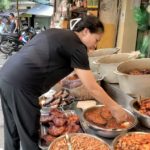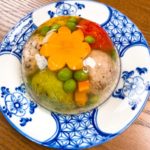Moc Van Am, or cloudy meat jelly, is a traditional dish in Hanoi that is almost forgotten, especially during spring celebrations like Tet. It used to be an essential part of the Tet feast tray, which consisted of “six bowls and eight plates” meticulously and ingeniously prepared by grandmothers.
| The Moc Van Am is a collection of five meatballs in five different colors, representing the Wuxing or Five Elements and symbolizing prosperity in the New Year. This unique dish is a specialty of Nguyen Phuong Hai, a culinary expert in Hanoi. |
Moc, or steamed pork meatballs, have been a part of Hanoi’s culinary tradition since the Le Dynasty. They originated in Moc Village, Nhan Chinh Commune, which is now Nhan Chinh Ward in Thanh Xuan District, Hanoi. This village was the hometown of many ancient royal chefs. Legend has it that one of them created Moc Van Am and presented it to the king, who generously rewarded him. As a result, the dish became exclusive to the king’s meals and banquets. Over time, Moc Van Am has become a popular dish on the Tet menu for ordinary people in Hanoi.
The main ingredients of Moc Van Am are raw pork paste and two types of pork rind. Shredded pork skin is mixed with shredded white wood ear, raw pork paste, pepper, and spices. Thorough mixing is crucial to achieve a crispy and chewy texture. After this step, the grandmothers would often take a break. Some of the pork rind is boiled and added to the broth, creating a cloudy appearance in the jelly, hence the name “van am” or “cloudy.” However, this distinct characteristic has been forgotten even by the older cooks in Hanoi.
| A traditional Vietnamese Tet feast prepared by culinary expert Nguyen Phuong Hai. |
The other type of pork rind is deodorized with chopped ginger wine, then boiled to make the broth. Skimming off the scum and adding spices are essential steps. The pork rind can be accompanied by pork shoulder and leg bones, soaked in saltwater and ginger wine, and blanched before boiling. Some families even add dry-roasted peanut worms and simmer the broth for several hours until it becomes clear and ivory-colored.
Now let’s focus on the meatballs. Various natural ingredients are used for coloring: green from medicinal herbs like Sabah snake grass, Chinese folding leaves, pandan leaves, and magenta leaves; yellow from gardenia seeds soaked in boiling water; red from gac fruit seeds beaten with strong wine; black from chopped wood ear or shiitake mushrooms; and white from the pork paste mixed with white wood ear. The mixture of pork rind shreds, diced neck fat, and white wood ear is divided into five portions. Each portion is then mixed with one of the colorings using a separate set of spoons and bowls. When kneading the meatballs, it is important to wet your palms with a little water. This step requires clean, bare hands without gloves. Each meatball should be slightly larger than a large Indochina dragon plum or the size of a peeled water chestnut, and flattened.
After steaming, the meatballs are left to cool and arranged in small bowls. The order of the meatballs is not random. It follows the cycle of mutual generation among the Five Elements. Specifically, the white ball (metal) is followed by the black ball (water), the green ball (wood), the red ball (fire), and the yellow ball (earth), which is placed next to the white ball on the other side.
| Moc Van Am is a delicate, beautiful, and delicious dish from ancient Hanoi. |
The meatballs are adorned with wisps of pork rind scattered around the bowl’s rim, and then cooled, boiling water is poured in. Nowadays, refrigeration makes it easier for the broth to solidify, but in the past, frosty weather was needed to attain the ideal consistency.
Before being served, the bowl of Moc Van Am is first offered to the ancestors on the altar. After the incense has burnt out, the grandmother takes the bowl down, gently shakes it, and places it upside down on a plate. Then, the bowl is removed, leaving behind a delicious cloudy meat jelly that amazes all the family members gathered around the tray!
A few years ago, a friend of mine, who is a professional cooking instructor on social media platforms and also from Hanoi, recreated this dish. He invited me to try it. The presentation was beautiful, just like in the old days, but I couldn’t help but wish for a few wisps of rind floating at the bottom of the dish. The size of the dish seemed larger than the ones my grandmother used to make, as far as I can remember. Although it was difficult to prepare, my family couldn’t imagine an old-fashioned Tet feast without Moc Van Am.
Chef promotes the quintessence of Vietnamese cuisine
NDO – Starting from its first video posted more than one year ago on the traditional food offerings of the Vietnamese people during the Tet (lunar New Year) festival, the YouTube channel Bep Nha Chau (My Family’s Kitchen) by chef Nguyen Phuong Hai has uploaded nearly 130 vlogs introducing viewers to the essence of Vietnamese dishes across the country, making it a favourite place for lovers of Vietnamese cuisine.









